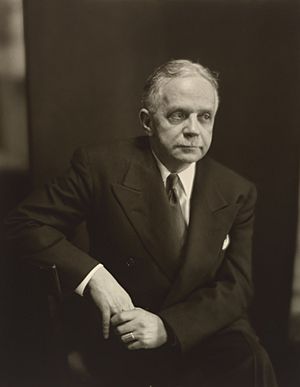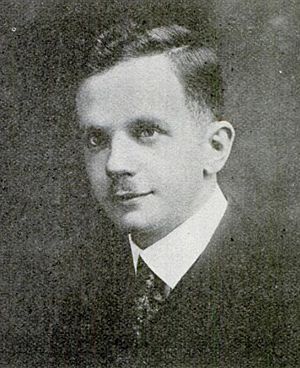Walter White (NAACP) facts for kids
Quick facts for kids
Walter Francis White
|
|
|---|---|

c. 1950 photograph by Clara Sipprell
|
|
| Executive Secretary of the National Association for the Advancement of Colored People | |
| In office 1929–1955 |
|
| Preceded by | James Weldon Johnson |
| Succeeded by | Roy Wilkins |
| Personal details | |
| Born | July 1, 1893 Atlanta, Georgia, U.S. |
| Died | March 21, 1955 (aged 61) New York City, New York, U.S. |
| Spouses |
Gladys Powell
(m. 1922; div. 1949)Poppy Cannon
(m. 1949) |
| Children | 2, including Jane |
| Education | Atlanta University (BA) |
Walter Francis White (July 1, 1893 – March 21, 1955) was an American civil rights leader. He worked to end racial segregation and unfair voting rules. For 25 years, from 1929 to 1955, he led the National Association for the Advancement of Colored People (NAACP). He first joined the NAACP in 1918 as an investigator.
White was also a writer, creating novels and essays. He graduated from Atlanta University (now Clark Atlanta University) in 1916. In 1918, James Weldon Johnson invited White to join the NAACP staff in New York. White became Johnson's assistant. He traveled to the Southern United States to investigate lynchings and riots.
Because White had light skin, he sometimes appeared to be white. This helped him investigate dangerous situations and stay safe. He became the head of the NAACP in 1929. He worked with President Truman to end segregation in the military after World War II.
Under White's leadership, the NAACP created its NAACP Legal Defense and Educational Fund. This fund fought many legal battles against segregation. One big success was the 1954 Brown v. Board of Education case. The Supreme Court ruled that separate schools for black and white children were unfair. White also helped the NAACP grow its membership to almost 500,000 people.
Contents
Early Life & Education
Walter White was the son of George and Madeline White. His father worked for the postal service, which was a respected job. His mother was a teacher. Both parents had attended Atlanta University. Walter grew up in Atlanta and went to public schools there. He finished high school in 1912 and college in 1916.
White's family was part of the First Congregational Church. This church was important for black people in Atlanta.
Family Background
Walter White had a mixed family background. He had both African and European ancestors. He often said, "I am a Negro. My skin is white, my eyes are blue, my hair is blond." This meant he looked white but identified as black. His family had very light skin. His mother, Madeline, had blue eyes and blonde hair.
White's grandmother, Marie Harrison, was born into slavery. Her mother was named Dilsia. Marie's father was William Henry Harrison, who later became president of the United States. Marie and some of her siblings were sold to another owner. Marie later had children with a wealthy white man named Augustus Ware. He bought her a house and passed on some money to their children. Even though Walter and his family could have passed as white, they chose to live as part of the black community in Atlanta.
Childhood Experiences
Walter's parents taught their children to work hard. Walter once threw a rock at a white child who used a mean word. This happened when Walter was drinking from a water fountain meant for black people. Experiences like this helped White understand his identity. He learned how to appear white, which he later used to stay safe as a civil rights activist.
Career Highlights
Walter White went to Atlanta University, a historically black college. After graduating in 1916, he worked for an insurance company. He also helped start a local chapter of the NAACP in Atlanta. He worked to improve schools for black children, who often had less funding.
In 1918, James Weldon Johnson invited White to work at the NAACP's main office in New York City. White became an assistant secretary. He started investigating lynchings in the South. Lynchings were violent killings, often by mobs, usually targeting black people. White's light skin and sharp mind made him very good at this dangerous work. He could pretend to be white to gather information and stay safe.
White sometimes joined groups like the Ku Klux Klan undercover. This helped him expose people involved in violence. In Little Rock, Arkansas, he had to escape by train because people found out he was black. The NAACP shared information about these crimes, but Southern governments rarely punished those responsible.
White was a very good speaker. Roy Wilkins, who took over from White at the NAACP, said White was "one of the best talkers I've ever heard." Walter White always spoke out against segregation and unfair treatment.
Family Life
Walter White married Gladys Powell in 1922. They had two children: Jane White, who became an actress, and Walter Carl White. Their marriage ended in divorce in 1949.
After his divorce, White married Poppy Cannon. She was a white South African magazine editor. This caused some controversy among his black colleagues. Some people thought he wanted to be white. His son even changed his name to Carl Darrow.
Marie Harrison's Story
Marie Harrison was Walter White's grandmother. She was born into slavery to a mother named Dilsia. Marie's father was William Henry Harrison, who later became a U.S. President. When Harrison decided to run for president, he gave Marie and some of her siblings to his brother. His brother then sold them to Joseph Poythress in LaGrange, Georgia.
Leading the NAACP
Investigating Violence
White used his ability to "pass" as white to investigate lynchings and race riots in the South. He could talk to white people as if he were one of them. He could also talk to black people as one of them. This work was very risky. He investigated many lynchings and riots, often risking his life.
In his book, A Man Called White, he wrote about almost joining the Ku Klux Klan undercover. He got letters from a KKK leader, Edward Young Clark. White used this access to learn about the Klan's plans against civil rights. He shared this information with the U.S. Department of Justice and the New York Police Department.
White investigated the Elaine massacre in October 1919. In this event, white mobs and soldiers killed many black sharecroppers in Arkansas. The sharecroppers were trying to organize a union. White published his findings in newspapers like the Chicago Daily News and the NAACP's magazine, The Crisis.
The NAACP helped the black men who were wrongly convicted after the riot. The case went to the U.S. Supreme Court. The Court overturned the convictions. It ruled that the original trial was unfair because of the threats and intimidation.
Scottsboro Trial Involvement
One of White's first big challenges as NAACP leader was the Scottsboro Trial in 1931. Nine black teenagers were arrested in Alabama after a fight on a train. The Communist Party and the NAACP both wanted to represent the black community in this case.
White believed the NAACP needed to stay separate from the Communist Party. He thought that being linked to communism would make it harder to gain civil rights. Even though the Communist Party got involved first, White and the NAACP continued to help the Scottsboro boys. They saw it as part of their larger fight for justice.
Fighting for Anti-Lynching Laws
White strongly supported federal laws against lynching. However, Southern politicians in the Senate blocked these bills. White's research showed that most lynching victims were black. He believed that prejudice and economic competition caused such violence.
In the late 1910s, many black people moved from the South to the North for jobs. This was called the Great Migration. This led to more competition for jobs and housing, causing violence in Northern cities. White also investigated terrible violence in the South. One case involved a pregnant black woman who was burned alive.
In 1922, the Dyer Anti-Lynching Bill passed easily in the House of Representatives. This was the first bill since the Civil War to protect black people from lynchings. But Southern senators stopped it from becoming law. Black people in the South had lost their right to vote, so white Democrats controlled politics there.
White continued to push for other civil rights laws, but they were also defeated. Even though the bills didn't pass, White and the NAACP gained a lot of public support. By 1938, a poll showed that most Americans, including many Southerners, supported an anti-lynching law. White also helped create strong alliances among civil rights activists.
Literary Achievements
Walter White was a key figure in the "New Negro" movement, also known as the Harlem Renaissance. This was a time when black American artists and writers created many important works. Harlem in New York City became a center for black intellectual and artistic life.
White wrote several well-known books. These included the novels Fire in the Flint (1924) and Flight (1926). He also wrote non-fiction books like A Rising Wind (1945) and his autobiography, A Man Called White (1948). His last book, How Far the Promised Land, was published in 1955.
Awards and Recognition
- 1927 – White received the Harmon Award for his book Rope and ***: An Biography of Judge Lynch, a study of lynching.
- 1937 – He was given the Spingarn Medal by the NAACP. This award is for outstanding achievements by an African American.
- 2002 – Molefi Kete Asante included Walter Francis White in his list of 100 Greatest African Americans.
- 2009 – White was added to the Georgia Writers Hall of Fame.
Death
Walter White passed away from a heart attack in New York City on March 21, 1955. He was 61 years old.
See also
Images for kids




